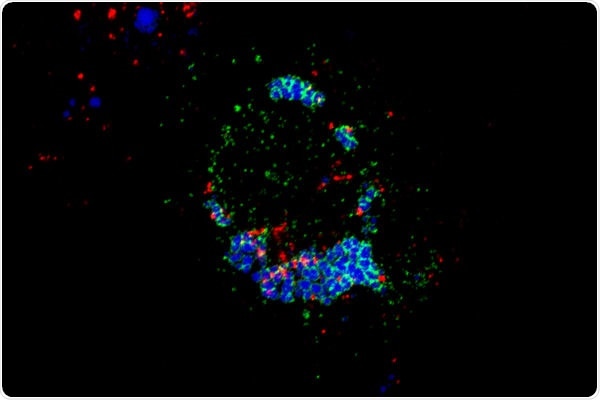A team of researchers from the Universitat de Barcelona (UB) and the August Pi i Sunyer Biomedical Research Institute (IDIBAPS) discovered a mechanism associated with the movement of cholesterol within cells.

Confocal microscopy image showing SNX13 protein (green) in regions of the endoplasmic reticulum contacting lipid droplets (blue) and lysosomes in which the BMP lipid is present (red). Image Credit: Universitat de Barcelona.
The research demonstrates how the SNX13 protein plays a significant role in transporting lipid outside of liposomes, which are organelles that carry out cellular digestion. The study was published in the Journal of Cell Biology.
These findings may have implications for the development of future treatments for pathologies caused by dysfunctions in intracellular cholesterol transport, like Niemann-Pick type C1 disease.
The study includes lecturers from the UB’s Faculty of Medicine and Health Sciences and the CELLEX Biomedical Research Centre (IDIBAPS-UB) Albert Lu, the article’s first author, and Carles Enrich, along with researchers from Stanford University.
The harmful effects of unbalanced cholesterol levels
The majority of the cholesterol that cells utilize emerges from outside, where it enters the lysosomes and is assigned to different intracellular compartments. However, the precise molecular events that control the exit of cholesterol from this organelle and its transport towards the membrane and the cell endoplasmic reticulum remain unknown. The goal of this study was to investigate the mechanism by which cholesterol exists in lysosomes.
This process requires the coordinate action of NPC1 and NPC2 transporters that, together with the bis(monoaclyglycero)phosphate (BMP) lysosomal lipid, mobilize and export the free cholesterol.”
Carles Enrich, Lecturer, Faculty of Medicine and Health Sciences, Universitat de Barcelona
The control of intracellular cholesterol trafficking and the amount of cholesterol received by cellular organelles is critical for the balance (or homeostasis) of cholesterol in the cell. Inconsistencies or disorders in its transport lead to an imbalance, which results in disorders like Niemann-Pick type C disease.
Mutations in the lysosomal cholesterol transporters NPC1 and NPC2 cause this pathology, which currently has no cure. This disorder restricts cholesterol and other fats from being properly metabolized and has serious consequences on the liver, spleen, and brain.
Genome-wide CRISPR/Cas9-type genetic screening
Scientists used CRISPR/Cas9-type genetic screenings in the genome to recognize the regulators of cholesterol balance. This method enabled a massive and parallel investigation of the human genome related to a specific biological process, resulting in a huge amount of data. In this research, the screening was performed under normal conditions while also blocking the NPC1 protein to classify cell elements that can transfer cholesterol concurrently to this transporter.
This strategy allowed the discovery of genes that, when excluded, alter intracellular cholesterol or BMP levels.
Our genetic screenings identified a high number of genes involved in the cholesterol and BMP metabolic regulation, whose role was unknown to date. In addition, we confirmed a tight correlation and regulation between the levels of these lipids.”
Albert Lu, Study First Author and Lecturer, Faculty of Medicine and Health Sciences, Universitat de Barcelona
One of the molecules involved in the system is SNX13, an endoplasmic reticulum protein that negatively regulates the withdrawal of cholesterol from lysosomes to the plasmatic membrane, thereby decreasing the amount of this lipid.
Given the lack of the function of NPC1, the reduction of SNX13 caused a redistribution of lysosomal cholesterol towards the plasmatic membrane, which indicates that SNX13 could be an important regulator in this cholesterol transport pathway.”
Albert Lu, Study First Author and Lecturer, Faculty of Medicine and Health Sciences, Universitat de Barcelona
An unexpected view of regulation mechanisms
These findings offer an unforeseen perspective on the regulation of these lipids, as there are a few substitute mechanisms—the majority of which are unidentified—that allow cholesterol to escape when the NPC1 transporter is interrupted or silenced.
“We described an alternative pathway regulated by anexin-A6, and with this new study we provide new evidence showing that there can be alternative exit routes for the lysosomal cholesterol parallelly to the NPC1”, says Carles Enrich.
With the discovery of molecules that can counter the effects of NPC1 dysfunction, such as SNX13, the researchers further state that this method could lead to the discovery of “future therapeutic targets in the treatment of Niemann-Pick type C disease, since a better knowledge of the molecules that take part in the contact between organelles can allow the manipulation of the transport of lipids and ions and re-establish the cellular homeostasis.”
Source:
Journal reference:
Lu, A., et al. (2022) CRISPR screens for lipid regulators reveal a role for ER-bound SNX13 in lysosomal cholesterol export. Journal of Cell Biology. doi.org/10.1083/jcb.202105060.